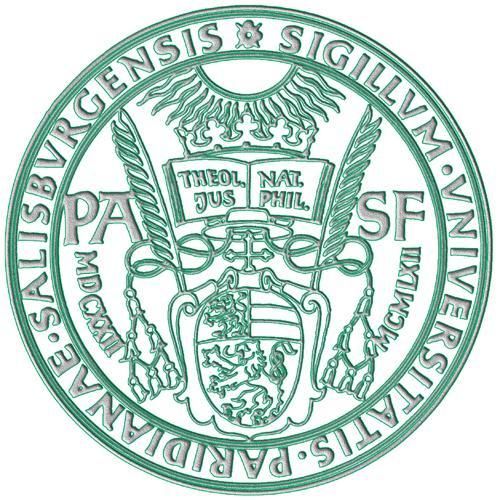Request Demo
Last update 09 Sep 2025

Universität Salzburg
Last update 09 Sep 2025
Overview
Tags
Hemic and Lymphatic Diseases
Neoplasms
Small molecule drug
Disease domain score
A glimpse into the focused therapeutic areas
No Data
Technology Platform
Most used technologies in drug development
No Data
Targets
Most frequently developed targets
No Data
| Disease Domain | Count |
|---|---|
| Hemic and Lymphatic Diseases | 1 |
| Neoplasms | 1 |
| Top 5 Drug Type | Count |
|---|---|
| Small molecule drug | 1 |
| Top 5 Target | Count |
|---|---|
| Class IIA HDACs(Histone deacetylases, class IIA) | 1 |
Related
1
Drugs associated with Universität SalzburgTarget |
Mechanism Class IIA HDACs inhibitors [+1] |
Originator Org. |
Active Indication |
Inactive Indication- |
Drug Highest PhasePreclinical |
First Approval Ctry. / Loc.- |
First Approval Date- |
31
Clinical Trials associated with Universität SalzburgNCT07059234
The Motor Activity - Subjective Energy (MASE) Project: Neurobiological and Digital Phenotyping Towards Digital Mental Health Interventions in Depression
This approach utilizes accelerometry to measure NEA and electronic diaries for real-time psychological assessments, overcoming limitations of traditional methods such as retrospective bias and low ecological validity. Brief episodes of physical activity in daily life, which are distinctly different from structured exercise sessions, are generally linked to improved affective well-being. Notably, feelings of energy are particularly associated with incidental, unstructured, and non-exercise activities. Clinically, psychomotor retardation and diminished mood are key diagnostic features of MDD, with evidence suggesting that lower motor activity differentiates MDD patients from controls and that increased activity correlates with treatment response. In this context, the MASE project aims to design personalized BA interventions that focus on increasing NEA and, in turn, enhancing subjective energy levels to reduce depressive symptoms and prevent relapse.
Start Date01 Sep 2025 |
Sponsor / Collaborator  University of Bern University of Bern [+5] |
NCT05867706
The Psychobiological Adjustment to Bereavement Among Cancer Caregivers
The death of a spouse is considered one of the most stressful and impactful life events and is associated with increased morbidity and premature mortality. Early identification of individuals who are most at risk for poor health outcomes following bereavement is an important aim of precision medicine and disease prevention initiatives. A better understanding of caregiver burden and bereavement-related distress and its implication for health is a clinically-relevant step toward the development of treatments that improve health outcomes in bereaved spouses. This study aims to map profiles of individual differences in short- and long-term adjustment to loss, according to psychological (e.g., depression, stress, grief severity) and biological markers (e.g., inflammation, cortisol) over time.
Start Date01 Oct 2024 |
Sponsor / Collaborator  University of Zurich University of Zurich [+2] |
NCT06538675
Process and Outcome Evaluation of Psychotherapeutic Approaches At the Outpatient Clinic for Psychotherapy of the Paris Lodron University Salzburg
In this study, adult patients and therapists at the Outpatient Clinic for Psychotherapy of the Paris Lodron University Salzburg will complete questionnaires throughout the course of psychotherapy in order to evaluate the course and outcome of psychotherapy.
Start Date30 Sep 2024 |
Sponsor / Collaborator |
100 Clinical Results associated with Universität Salzburg
Login to view more data
0 Patents (Medical) associated with Universität Salzburg
Login to view more data
5,202
Literatures (Medical) associated with Universität Salzburg31 Dec 2025·International Journal of Qualitative Studies on Health and Well-Being
„If you ask me … “: experienced cardiac rehabilitation patients’ perspectives on maintaining regular heart-healthy physical activity
Article
Author: Pfannerstill, Franziska ; Gutenberg, Johanna ; Crutzen, Rik ; Kulnik, Stefan Tino ; Propst, Eva Maria
PURPOSE:
Despite the proven benefits of regular exercise and physical activity (PA), engagement of cardiac patients and adherence to recommended PA remain challenging. This study aimed to interview cardiac patients who are experienced in maintaining a physically active lifestyle to gain insight into how regular PA can become part of one's life after a cardiac event.
METHODS:
Twenty-five cardiac patients (18 men and 7 women; age range 39-83 years) participated in audio-recorded, semi-structured qualitative interviews. Patients were recruited from a clinical site in Salzburg, Austria, which offers ongoing weekly exercise classes under medical supervision for cardiac patients. Interview transcripts were analysed against the background of the Reasoned Action Approach and coded inductively.
RESULTS:
Eight themes were generated that elucidated patients' long-term engagement with PA: well-being and physical benefits; health literacy; community, groups, and partners; attitude, expectation and mindset; professional supervision; digital technology; nice distractions; and possibility of personalized tailoring. These themes are linked to several elements of the Reasoned Action Approach, including attitude, norm, behavioural control, skills, and environment.
CONCLUSION:
This study highlights important aspects with respect to shaping a positive attitude towards PA and the significance of the social environment in establishing regular PA in cardiac patients.
01 Nov 2025·MICROBIAL PATHOGENESIS
The function of the HtrA protease in maintaining homeostasis of the human pathogen Helicobacter pylori
Article
Author: Zarzecka, Urszula ; Roncarati, Davide ; Mruk, Inez ; Musiał, Natalia ; Czaplewska, Paulina ; Godlewska, Renata ; Bielecka, Małgorzata ; Diechler, Sebastian ; De Re, Valli ; Skorko-Glonek, Joanna ; Figaj, Donata ; Wessler, Silja ; Ambroziak, Patrycja ; Repetto, Ombretta
Helicobacter pylori is a Gram-negative bacterium known to cause persistent infections in humans. HtrA protease is one of the most important secreted virulence factors of this pathogen and is responsible for damaging intercellular junctions between the gastric epithelial cells. Although this protein is regarded as essential in H. pylori, very little is known about its function in the bacterial cell physiology. In this work, we attempted to expand the knowledge in this aspect. We found that deletion of the htrA gene caused significant alterations in the membrane proteome, including changes in the content of many outer membrane proteins. This translated into modifications in the cell surface properties, affecting the function of the outer membrane as a barrier in the mutant cells. Interestingly, maintaining the homeostasis of cellular envelope was dependent mainly on the chaperone activity; the role of proteolytic activity was far less important in this respect, considering the proteomic data and the surface properties of the bacteria. In vitro, HtrA degraded several H. pylori proteins, including proteins involved in virulence: oncogenic effector CagA, whose degradation products accumulated in H. pylori ΔhtrA cells, and the iron-regulated OM protein FrpB4. In conclusion, the results presented in this work underline the very important role of the HtrA protein in the maintenance of the cellular envelope proteostasis in H. pylori. Disrupted homeostasis in the absence of HtrA function can significantly impair the physiology of the whole H. pylori cell, which may affect its virulent properties.
01 Oct 2025·CLINICAL NEUROPHYSIOLOGY
Brain-breathing interaction during MRI-related anxiety
Review
Author: Rassler, Beate ; Andrade, Alexandre ; Klimesch, Wolfgang ; Schwarz, Gerhard ; Pfurtscheller, Gert ; Kaminski, Maciej ; Pfurtscheller, Klaus
Nasal breathing can entrain fast oscillations in the prefrontal cortex and limbic systems, as experiments with rodents and intracranial EEG recordings in patients have shown. Recently, it was demonstrated that the activity of the amygdala and hippocampus can also be studied non-invasively, using functional magnetic resonance imaging (fMRI). When simultaneously recording BOLD signals, respiration and cardiac RR interval (RRI) time courses, and applying a multivariate autoregressive (MVAR) model combined with Granger causality analysis, it becomes possible to assess directed coupling, or information flow, between brain structures and the body organs (i.e., heart and lung). Klimesch's binary hierarchy model links fast neural oscillations in the gamma and beta range with medium-range rhythms of the heart and respiration, as well as with infra-slow BOLD oscillations (<0.1 Hz), all aimed to minimize the brain's energy demands. This model predicts three preferred breathing frequencies, 0.32 Hz, 0.16 Hz, and 0.08 Hz, as well as an infra-slow oscillation (ISO) at 0.02 Hz. Remarkably, the preferred breathing frequency of 0.32 Hz (∼20 cycles per minute) appears to be a universal marker of anxiety, which is observed in patients and healthy participants during MRI sessions.
1
News (Medical) associated with Universität Salzburg24 Apr 2024
When pathogens invade the body, the immune system must react immediately to prevent or contain an infection. But how do our defence cells stay ready when no attacker is in sight? Scientists have found a surprising explanation: They are constantly stimulated by healthy tissue. This keeps them active and ready to respond to pathogens. Based on this insight, future medications could be devised to selectively enhance our immune system's attention.
When pathogens invade the body, the immune system must react immediately to prevent or contain an infection. But how do our defence cells stay ready when no attacker is in sight? Scientists from Vienna have found a surprising explanation: They are constantly stimulated by healthy tissue. This keeps them active and ready to respond to pathogens. Based on this insight, future medications could be devised to selectively enhance our immune system's attention. The study has been published in the journal Nature Immunology.
Communication is crucial in immune defence. When a virus infects a cell, the cell releases signalling molecules. This alerts immune cells, and our immune system is rapidly activated. Immune cells process such signals through the JAK-STAT signalling pathway -- named after Janus, the two-faced Roman god of beginnings and endings. This pathway links signal detection on the cell surface to the core regulatory machinery of immune cells, activating a set of genes and putting the immune cells into attack mode.
Even when there is no immediate threat, our immune cells must remain vigilant. At the same time, they should not cause damage through unnecessary activity, as it is the case with autoimmune diseases. How our defence cells maintain this balance is poorly understood. A team of research groups from Vienna ( ) has now put forward an explanation in the journal Nature Immunology: "The same JAK-STAT signalling pathway that activates immune cells during an infection also keeps them on standby when no pathogens are in sight," explains Christoph Bock, Principal Investigator at CeMM and Professor at the Medical University of Vienna. When encountering a pathogen, the immune cells thus only need to increase the signalling intensity, which is much faster than turning on a completely new signalling pathway.
To reach this conclusion, the team examined twelve mutant mouse models, each with a genetically altered component of the JAK-STAT signalling pathway. These mice were raised free of diseases and compared with genetically unaltered mice. It was observed that the mutant mice lacked some of the characteristic gene activity and epigenetic regulation of the standby state. Something similar happened when defence cells were removed from their tissue environment and kept in cell culture: They lost their characteristic standby state and even parts of their identity as immune cells.
The team analysed the gene expression and epigenetics of immune cells and tissue samples collected by seven research teams from Vienna. "Our analyses were only possible due to the establishment of uniform laboratory standards and robust statistical methods," explains bioinformatician Nikolaus Fortelny (first author and now Professor at the University of Salzburg). "We showed that JAK-STAT signalling has different functions when immune cells are on standby than during the active response to pathogens," explains Matthias Farlik (also a first author and now group leader at the Medical University of Vienna).
"JAK-STAT signalling is a central mechanism of our body for communicating immune signals," summarizes Thomas Decker (Professor at the Max Perutz Labs and the University of Vienna) the relevance of the study. "Our study provides insights into the role of the immune system: not only does it react to attacks, but it also maintains vigilance without causing unnecessary damage," adds Mathias Müller (Professor at the University of Veterinary Medicine Vienna). Genes of the JAK-STAT signalling pathway are sometimes pathologically altered in individuals with immune diseases and cancer. Therefore, this research also provides possible approaches for future therapies.
100 Deals associated with Universität Salzburg
Login to view more data
100 Translational Medicine associated with Universität Salzburg
Login to view more data
Corporation Tree
Boost your research with our corporation tree data.
login
or

Pipeline
Pipeline Snapshot as of 12 Dec 2025
The statistics for drugs in the Pipeline is the current organization and its subsidiaries are counted as organizations,Early Phase 1 is incorporated into Phase 1, Phase 1/2 is incorporated into phase 2, and phase 2/3 is incorporated into phase 3
Preclinical
1
Login to view more data
Current Projects
| Drug(Targets) | Indications | Global Highest Phase |
|---|---|---|
TMP269 ( Class IIA HDACs ) | Acute Myeloid Leukemia More | Preclinical |
Login to view more data
Deal
Boost your decision using our deal data.
login
or

Translational Medicine
Boost your research with our translational medicine data.
login
or

Profit
Explore the financial positions of over 360K organizations with Synapse.
login
or

Grant & Funding(NIH)
Access more than 2 million grant and funding information to elevate your research journey.
login
or

Investment
Gain insights on the latest company investments from start-ups to established corporations.
login
or

Financing
Unearth financing trends to validate and advance investment opportunities.
login
or

AI Agents Built for Biopharma Breakthroughs
Accelerate discovery. Empower decisions. Transform outcomes.
Get started for free today!
Accelerate Strategic R&D decision making with Synapse, PatSnap’s AI-powered Connected Innovation Intelligence Platform Built for Life Sciences Professionals.
Start your data trial now!
Synapse data is also accessible to external entities via APIs or data packages. Empower better decisions with the latest in pharmaceutical intelligence.
Bio
Bio Sequences Search & Analysis
Sign up for free
Chemical
Chemical Structures Search & Analysis
Sign up for free
